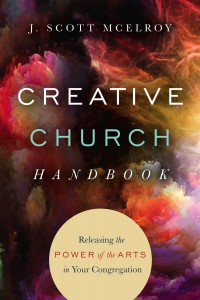 Welcome to the online extras and resources for Chapter 1: A Renewal of the Arts and Creativity in the Church of The Creative Church Handbook. What you’ll find here is material that is helpful and important, but couldn’t be included in the book because of space constraints. Some thoughts include a reference to the specific page they would have appeared on.
Welcome to the online extras and resources for Chapter 1: A Renewal of the Arts and Creativity in the Church of The Creative Church Handbook. What you’ll find here is material that is helpful and important, but couldn’t be included in the book because of space constraints. Some thoughts include a reference to the specific page they would have appeared on.
For information and discussion on similar topics see The New Renaissance Arts Movement site at TheNewR.org. For questions, comments, or use permissions you may contact the author directly at Scott (at) TheNewR.org.
Visit our CreativeChurchArtsIdeas.org website for more ideas for creativity and arts ministry in the local church!
Chapter 1: A Renewal of the Arts and Creativity in the Church
Definitions of Terms Used Throughout the Book
It seems good to clarify a few of the terms that are frequently used in this book.
The Arts: This term encompasses all artistic disciplines and expressions including, but not limited to, painting, music, sculpture, dance, writing, architecture, design, illustration, drama, puppetry, and so on. Music is certainly a pillar of the arts and the one art form that is consistently practiced and developed in most churches. So, when we talk of a lack of the arts in the Church, music is often the exception.
Creativity: For the purposes of this book, creativity is defined as the ability to arrange or utilize resources in any realm (physical, mental, spiritual, emotional) to address (solve, improve, change, explain, design) any situation (problem, project, void, need). This includes but it is not limited to art. Every person is endowed by God with creativity and has the opportunity to partner and collaborate with Him in the use of their creativity. In addition, creative skill in virtually any area can be enhanced and developed with use. Artists use creativity to arrange materials into works that are often appreciated primarily for their beauty or emotional or spiritual power.
Art plays a large role in the liturgy of life. I chose this term in analogy to liturgy
as we have it in church, the set forms in which we have molded our services. The liturgy
of life is the way we do things. Art creates the surroundings, designs the clothes, designs
the cup given to the winner or the sculpture that is the token of praise1 as with the
Oscar. In many ways the arts help. The organization of a solemn meeting, such as the
inauguration of a president, is in itself a work of art. It counts in how a restaurant is
designed, the art of interior design, so that even our eating is influenced.
Hans Rookmaaker, Art Needs no Justification, 1977
7 Levels of Creativity
C1: (Basic) The arrangement of actions, experiences, and insights that every person does to give meaning to their existence. (Ex: “I like the park. Today, I’ll go there.”)
C2: (General) General problem solving and personal expression. (Ex: “What if…?” or “I feel like singing!” or, “My kids need more vegetables. I’ll make broccoli tonight.”)
C3: (Amateur) Seen in those with a bent toward physical art-making, from beginner, to student, to near professional. (Ex: doodling, playing an instrument, working with any form of the arts for pleasure or learning.)
C4: (Professional) Exhibited in those working and making money from their creativity in “creative professions”. (Ex: Web Designers, Illustrators, Worship Leaders, etc.)
C5: (Genius) Present in those who are considered truly great in their creative field. (Ex: Michelangelo, Mozart, Thomas Edison.)
C6: (God) He who alone has created “out of nothing” (ex nilo).
C7: (Divine Collaboration) This can operate in believers at every level of creativity. It is creativity inspired by and infused with the Spirit of God. Of course, this is the foundation of creativity, since without God no human function is possible. But for this definition, it is the highest purpose of creativity, since humans were designed to actively collaborate with their Creator in specific situations.
With the quote from Bono of U2 on page 18, you might be interested in this interview where he clearly professes faith in Christ.
